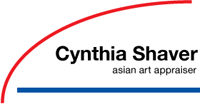My work is full of virtual office appointments. That is the silver lining of the covid pandemic: virtual office appointments are common now with interruptions and visual effect difficulties or the cat sleeping on the chair behind the newscaster. For me personally, my wheelchair disappears and is not a factor. Imagine that! Each call is different and feels quite personal. Virtually, I’m often inside someone’s home, looking at what they inherited. One virtual appointment included a collection of Asian textiles from a grandmother who was a textile historian. That gave me the value element to look for, why was this particular cloth chosen, the weave structure or the pattern or was it the dye selected. It was fun to explain to the heir what was unique about her group of special family treasures.
There were silk kimono, with different colors and textures. A beautiful white kimono had black cranes in flight over the bottom back half and sleeves, the background fabric a smooth silk satin with a fret pattern of damask weave. Not all silk patterned kimono are damask weave background, but are simply plain weave.
I determined the patterned weave is why this kimono was selected.
Another silk kimono was completely different. The fabric was crepe, a crinkly feel called chirimen in Japanese, and regarded as the finest example of silk cloth available in Japan. As a customer in a kimono shop, that is the first value characteristic mentioned, the quality of the fibers. The pattern was of chrysanthemums, some showing bits of embroidery among the white petals, cranes with selected embroidered feathers and plum blossoms on a cream background. It is important to recognize how many different varieties of chrysanthemum there are and how important the flower is to the Japanese. It represented the throne, the Emperor, who descended from the Sun Goddess.
It is important to remember at first, the only image I had was of the wrinkled fabric sent by email, and then we start our virtual one-hour appointment to cover about twenty properties. On close inspection, I can see limited embroidery on the flowers, on the center petals, or one group of feathers on the crane. It was limited conspicuous consumption and a value saving technique of surface design. I also pointed out how plum blossoms have five rounded lobes versus cherry blossoms also with five lobes but have a dip in each of the blossoms.
All of this was my interpretation of her grandmother making decisions about kimono around turn of the 20th century. I enjoy putting my specific skill set to work, that’s why I’m the expert after more than 50 years studying and understanding Japanese textiles. It also speaks to the number of kimono I’ve seen, many thousands both in Japanese culture and outside, in private collections and public. Art on cloth. The texture,, then weave structure, and then the surface pattern.

